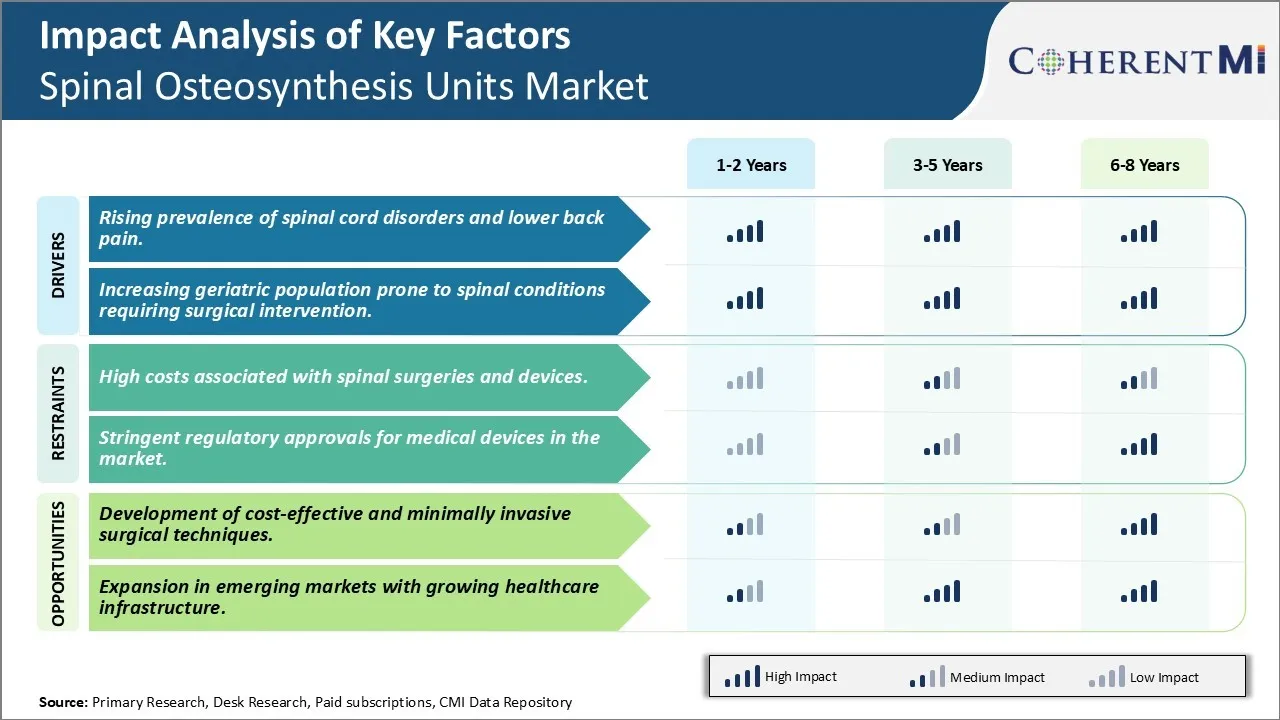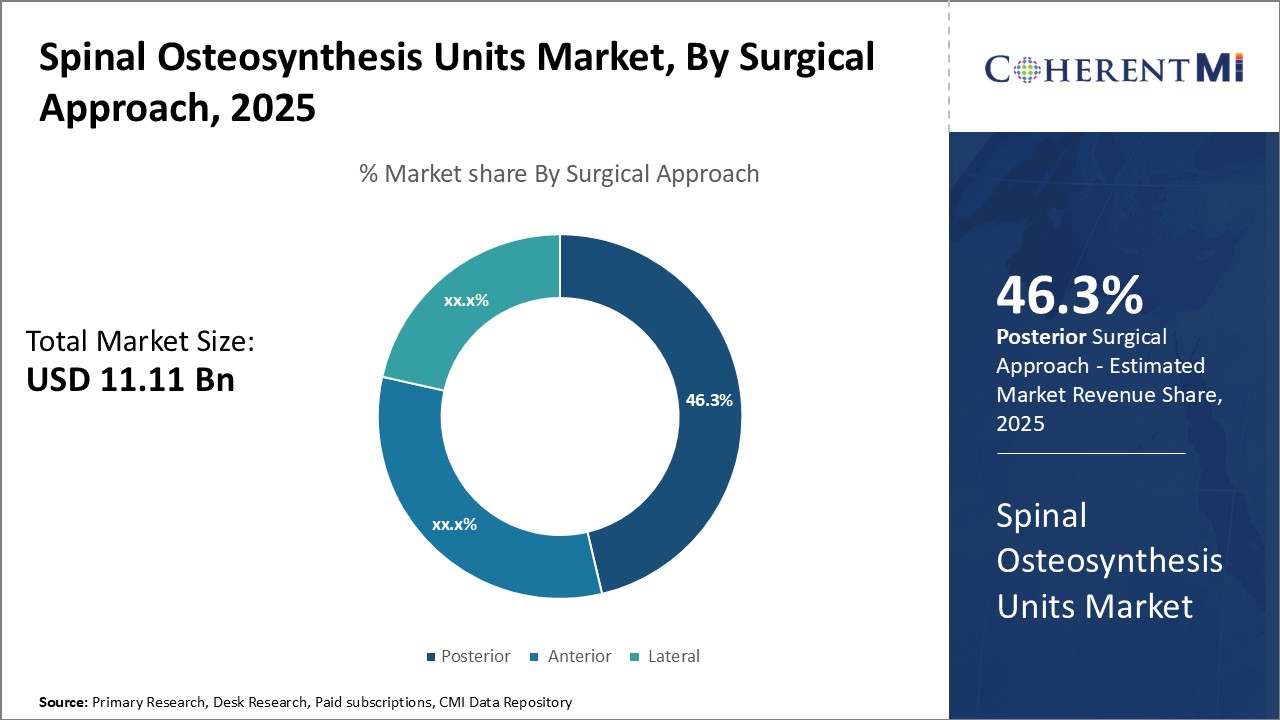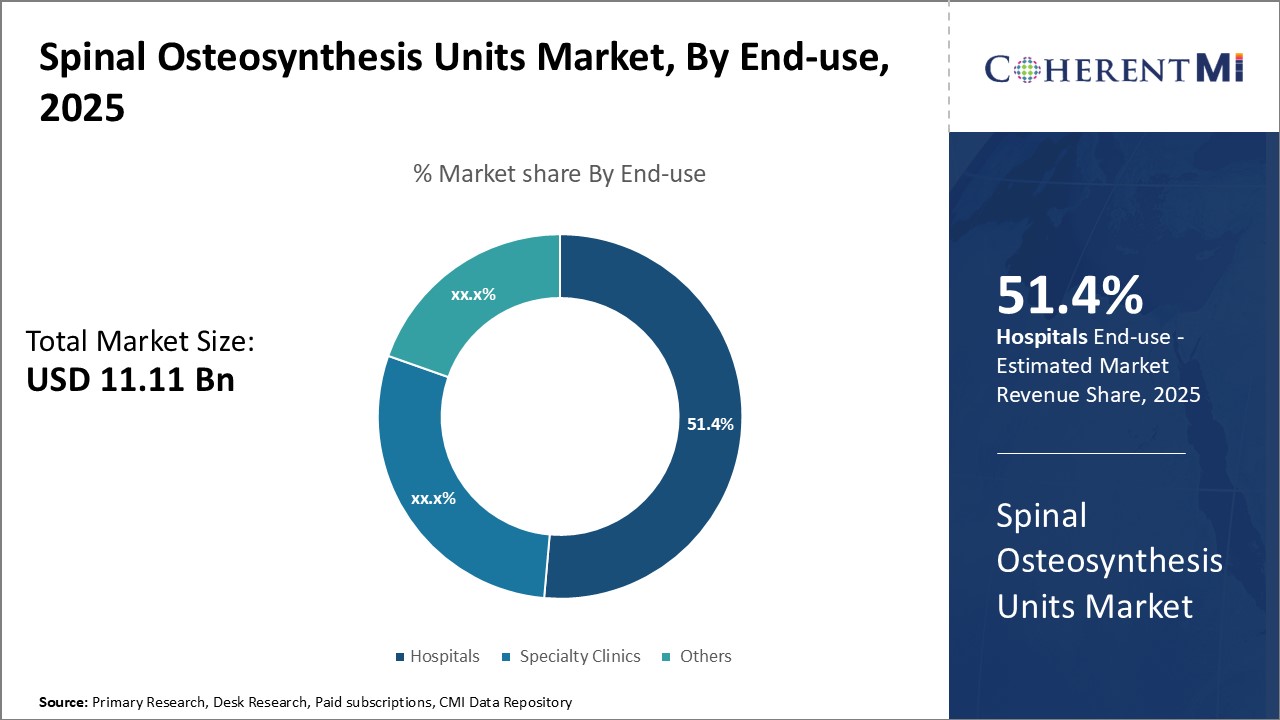Spinal Osteosynthesis Units Market Size - Analysis
The market is expected to witness positive growth over the forecast period due to increasing number of spinal surgeries owing to road accidents and improving healthcare infrastructure across developed and developing regions. The spinal osteosynthesis units market is expanding due to rising incidences of spinal disorders, technological advancements in spinal surgery, and the growing elderly population. These units, including plates, rods, and screws, are essential for spinal stabilization and fusion procedures. Major trends indicate an increased demand for minimally invasive surgeries and innovations in materials, such as titanium and bioresorbable devices. Major players focus on product development and strategic collaborations to enhance their market presence. Additionally, growing awareness about minimally invasive spine surgeries and availability of advanced osteosynthesis units will further aid the market expansion through 2032.
Market Size in USD Bn
CAGR8.4%
| Study Period | 2025-2032 |
| Base Year of Estimation | 2024 |
| CAGR | 8.4% |
| Market Concentration | Medium |
| Major Players | B.Braun, MEDIOX, Globus Medical, Lepu Medical Technology Co Ltd, LifeSpine, Inc and Among Others |
please let us know !
Spinal Osteosynthesis Units Market Trends
The incidences of spinal cord disorders and chronic lower back pain in the population is growing. These conditions have become quite common owing to lifestyle changes and rising stress levels among working professionals. Prolonged sitting hours in front of computers has weakened core muscles giving rise to back issues. With more awareness, people are also coming forth for diagnosis and treatment of minor back troubles which would otherwise have gone unnoticed. Obesity rates too have contributed as excess weight puts tremendous strain on the spinal column over time.
Spinal problems if left untreated can seriously impair quality of life through chronic pain and decreased mobility. This drives people to seek advanced treatment options even for relatively minor issues. Additionally, increased social security coverage and availability of low-cost healthcare loans are facilitating accessibility to costly surgical procedures. Also, advanced techniques like minimally invasive procedures are encouraging people to opt for intervention at early stages instead of prolonging pain through medication alone. Rising consumer awareness about such alternatives through online health portals is another factor propelling the spinal surgeries market.
Market Driver- Increasing Geriatric Population Prone to Spinal Conditions Requiring Surgical Intervention.
Deteriorating bones and softer discs render the aged more vulnerable to fractures, slipped discs, spinal stenosis and other conditions disrupting spinal alignment. Minor injuries causing no harm to younger individuals may cause long-term damage to fragile spinal architectures in old age. As people age, wear and tear naturally accumulates in the intervertebral joints making them stiffer and prone to ossification. This dampens shock absorption ability of discs leading to compression of nerves. Lack of calcium too adversely impacts bone mineral density in seniors negatively impacting structural integrity.
Rapid expansion of the geriatric demographic in developing nations is expected to majorly stimulate market volume in coming years. Favorable regulatory scenarios and third-party reimbursements are additionally encouraging the aged population to undergo specialized corrections for restoring pre-surgery levels of activity. Technological advancements allowing minimally invasive surgeries are also attracting seniors not otherwise comfortable with conventional open surgeries.

Spinal surgeries often require costly implants, devices and procedures to properly treat various spinal injuries and disorders. The devices used in spinal osteosynthesis like rods, plates, screws and cages can be very expensive. Additionally, spinal fusion surgeries which are commonly required procedures are also quite costly owing to long operating times and intensive in-hospital care needed post-surgery. This continues to remain a major challenge for widespread adoption of osteosynthesis procedures especially in developing nations where affordability is a major consideration for patients. The high device costs and surgical expenses can often outweigh the benefits if insurance or adequate reimbursement policies are not available. Most patients end up bearing significant out-of-pocket expenditures which acts as a deterrent. This cost burden on patients can negatively impact the market growth if not addressed properly. Healthcare systems will need to work on improving insurance coverage and bringing down costs of newer spinal technologies to make them more accessible and affordable for common patients.
Market Opportunity- Development of Cost-Effective and Minimally Invasive Surgical Techniques.
Key winning strategies adopted by key players of Spinal Osteosynthesis Units Market
Product Innovation: Developing innovative product offerings has been a key strategy for market leaders to gain competitive advantage. In 2020, DePuy Synthes (part of Johnson & Johnson) launched the VIPERTM Pedicle Screw System which offered improved screw purchase and easier rod adaption. This helped the company strengthen its portfolio for spinal fixation procedures.
Partnerships and Licensing Deals: Collaborating with other players through partnerships helps companies to enter new markets and segments. In 2020, NuVasive partnered with digital health provider Medtronic to integrate surgical planning tools with NuVasive's spinal hardware and implants. This strategic collaboration facilitated their entry into digital/navigation technology.
Segmental Analysis of Spinal Osteosynthesis Units Market
 Insights, By Surgical Approach, Posterior Contributes the Highest Market Share Owing to its Minimally Invasive Nature.
Insights, By Surgical Approach, Posterior Contributes the Highest Market Share Owing to its Minimally Invasive Nature.The posterior surgical approach segment dominates the spinal osteosynthesis units market due to various advantages it offers over other approaches. Posterior instrumentation techniques provide direct access to the posterior spinal elements like lamina, facets, and pedicles. This approach is less traumatic for patients as it does not require an anterior opening in the spine or disruption of the anterior longitudinal ligament.
Advancements in spinal fusion technology have made posterior osteosynthesis procedures less complex. Newer screw designs provide better anchorage in bone. Rods and plates made of titanium and stainless steel have enhanced strength and stiffness. Minimal tissue dissection and retraction results in less post-operative pain and faster recovery times for patients.

Insights, By End-Use, Hospitals Will Register a Remarkable Growth in the Forecast Period.
Post-operative care in hospitals enables close monitoring during critical recovery phase. Patients have round-the-clock access to emergency response teams and rehab specialists. This reduces complications and speeds up rehabilitation.
Additional Insights of Spinal Osteosynthesis Units Market
The global spinal osteosynthesis units market is poised for steady growth due to the rising prevalence of spinal disorders, increasing incidence of injuries, and the expanding geriatric population. North America dominates this market, driven by high rates of spinal injuries, robust research and development, and a strong focus on innovative product launches. Key players are continuously investing in technological advancements to enhance surgical outcomes, particularly through minimally invasive techniques and advanced fixation systems. Despite high costs and regulatory hurdles, the market presents substantial opportunities, especially in emerging regions where healthcare access is expanding. The posterior surgical approach remains the most popular due to its effectiveness and lower complication rates, highlighting the continued demand for spinal stabilization technologies.
Competitive overview of Spinal Osteosynthesis Units Market
The major players operating in the Spinal Osteosynthesis Units Market include B.Braun, MEDIOX, Globus Medical, Lepu Medical Technology Co Ltd, LifeSpine, Inc, Normmed Medical, Osimplant, ATEC Spine, Inc., TAEYEON Medical Co. Ltd, Nexxt Spine, LLC, Precision Spine, SIGNUS Medizintechnik GmbH, Naton Medical Group, Spineway France, CTL Amedica, ARCA-MEDICA GmbH and Watson Medical.
Spinal Osteosynthesis Units Market Leaders
- B.Braun
- MEDIOX
- Globus Medical
- Lepu Medical Technology Co Ltd
- LifeSpine, Inc
Spinal Osteosynthesis Units Market - Competitive Rivalry

Spinal Osteosynthesis Units Market
(Dominated by major players)
(Highly competitive with lots of players.)
Recent Developments in Spinal Osteosynthesis Units Market
- October 2022: Orthofix and SeaSpine entered a merger agreement to enhance their product offerings in spinal surgery, focusing on advanced spinal osteosynthesis units
- March 2021: Alphatec Holdings launched the InVictus Occipital-Cervical-Thoracic Spinal Fixation System, expanding their existing product line for better spinal fixation solutions.
Spinal Osteosynthesis Units Market Segmentation
- By Surgical Approach
- Posterior
- Anterior
- Lateral
- By End-use
- Hospitals
- Specialty Clinics
- Others

Would you like to explore the option of buying individual sections of this report?
Manisha Vibhute is a consultant with over 5 years of experience in market research and consulting. With a strong understanding of market dynamics, Manisha assists clients in developing effective market access strategies. She helps medical device companies navigate pricing, reimbursement, and regulatory pathways to ensure successful product launches.
Frequently Asked Questions :
How Big is the Spinal Osteosynthesis Market?
The Global Spinal Osteosynthesis Market is expected to value at USD 11.11 billion in 2025 and reach USD 19.54 billion by 2032.
What will be the CAGR of the Spinal Osteosynthesis Units Market?
The CAGR of the Spinal Osteosynthesis Units Market is projected to be 8.2% from 2024-2031.
What are the major factors driving the Spinal Osteosynthesis Units Market growth?
The rising prevalence of spinal cord disorders and lower back pain and increasing geriatric population prone to spinal conditions requiring surgical intervention are the major factor driving the Spinal Osteosynthesis Units Market.
What are the key factors hampering the growth of the Spinal Osteosynthesis Units Market?
The high costs associated with spinal surgeries and devices and stringent regulatory approvals for medical devices in the market are the major factor hampering the growth of the Spinal Osteosynthesis Units Market.
Which is the leading Surgical Approach in the Spinal Osteosynthesis Units Market?
Posterior is the leading surgical approach segment.
Which are the major players operating in the Spinal Osteosynthesis Units Market?
B.Braun, MEDIOX, Globus Medical, Lepu Medical Technology Co Ltd, LifeSpine, Inc, Normmed Medical, Osimplant, ATEC Spine, Inc., TAEYEON Medical Co. Ltd, Nexxt Spine, LLC, Precision Spine, SIGNUS Medizintechnik GmbH, Naton Medical Group, Spineway France, CTL Amedica, ARCA-MEDICA GmbH, Watson Medical are the major players.